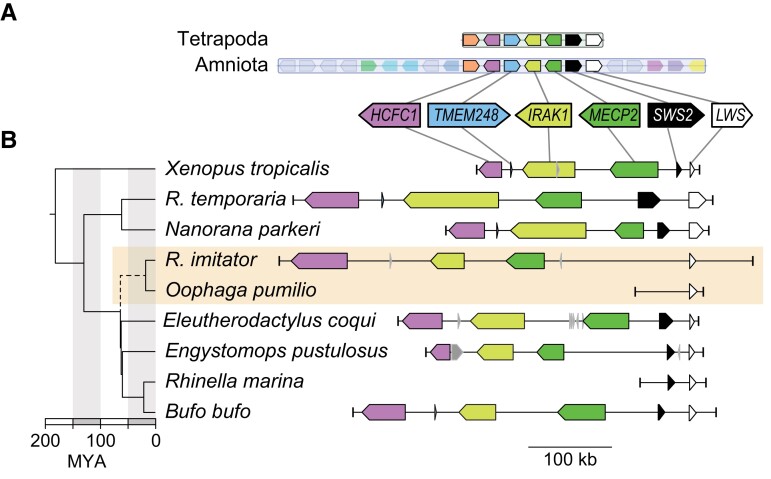Fig. 2.
(A) SWS2 is found in a syntenic block with LWS in the ancestors of all tetrapods (block 355) and in the ancestor of all amniotes (block 65). (B) The region in Xenopus tropicalis (chromosome 8, NC_030684:32108538-32360324) shows synteny with Rana (R.) temporaria (chromosome 9, NC_053497.1:22641469-22170306; Ranidae), Nanorana parkeri (unplaced scaffold, NW_017306743:511492-806940; Ranidae), Rhinella marina (contig ctg22529_RHIMB, ONZH01019223.1:1-80000; Bufonidae), Bufo bufo (chromosome 8, NC_053396.1:25948637-26357822; Bufonidae), Eleutherodactylus coqui (chromosome 9, CM034094.1:11013102-11351932; Eleutherodactylidae), Engystomops pustulosus (chromosome 10, CM033650.1:68367373-68196643; Leptodactylidae), which also all contain SWS2, MECP2, IRAK1, TMEM187, and HCFC1 upstream of LWS. However, SWS2 is absent in the scaffold containing LWS in two dendrobatid genomes (Oophaga pumilio [scaffold70671:1-49101] and Ranitomeya [R.] imitator [CAJOBX010072427.1, scaffold934:531527-1]). A dated chronogram (Feng et al. 2017) indicates that SWS2 may have been lost in the ancestral lineage (dashed line) leading to Dendrobatidae (orange box), between ∼70 and 40 Ma. Where coding regions were identified in genome assemblies but not annotated, we added annotations using blastp and blastn. Coding regions in gray had ambiguous blast results and thus were left without annotations.

